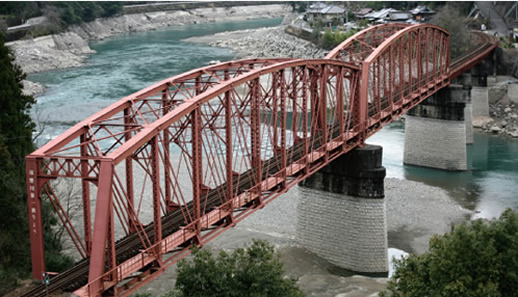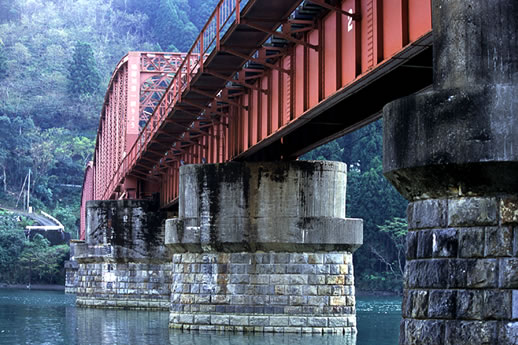
TOP>Inheritance group of Hisatsu Line
The arches American geometric pattern cast a jade shadow on the Kuma River.
The construction of Kyushu line depended on German technology.
But from Yatsushiro south ward the construction depended on American technology.
This arch was designed by Cooper Schneider and was built by an American Bridge company.
It is a truss bridge of the pin-binding method and is called truncate type.
There is an angle of skew and crosses the river diagonally.
Intricate and beautiful truss work can be seen from above from the road.
Even better from the river side village, pilings and bridge can be seen.
Beautiful truss bridge seen from down river.
【View point】
- Truncate trussed design of the bridge which is joined with pin is unusual.
- The part of truss is marked with “ 1906 AMERICAN BRIDGE CO NEW YORK U.S.A”
- There is the supporting beam which does not go against a flow of the Kuma River. The construction of the abutment pier part is made of brick and cut rock.
Beautiful truss bridge seen from down river
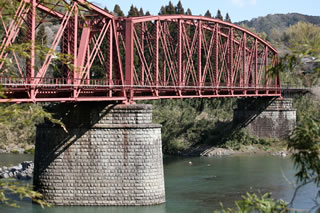
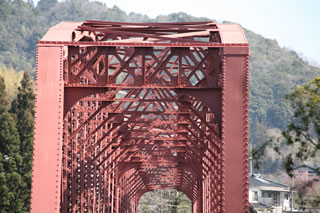 This truss bridge is made in New York as well as the first bridge on the Kuma River too.
Truncate still reduces diagonal structure which is a special feature.
It was completed in 1908. It is Class steel frame structure called the pin-binding method
Pratt truss. It is a road elevation plate garters bridge.
The supporting beam is flat product structure of a brick and the cut stone same as the first bridge on Kuma River.
Since Meiji Period, the iron structure bridge from America, it remains important heritage.
This truss bridge is made in New York as well as the first bridge on the Kuma River too.
Truncate still reduces diagonal structure which is a special feature.
It was completed in 1908. It is Class steel frame structure called the pin-binding method
Pratt truss. It is a road elevation plate garters bridge.
The supporting beam is flat product structure of a brick and the cut stone same as the first bridge on Kuma River.
Since Meiji Period, the iron structure bridge from America, it remains important heritage.【View Point】
- From the land bridge and railroad crossing, near the train at the train crossing, beautiful construction can be seen from all angles.
- We can observe Truncate structure and the pin-binding cutting down diagonally. The bridge can be seen from below while riding down river on the rapid course.
Trains coming from the mountain pass to the stone stable garage
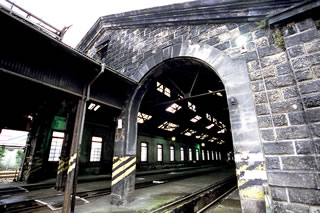 This stone garage is the only garage in current use within all of Japan.
It is built in welded pyroclastic rock peculiar to Kuma district.
Especially, the entrance arch is beautiful.
Previously, the garage was a blacksmith, where train parts were made in Meiji period.
This stone garage is the only garage in current use within all of Japan.
It is built in welded pyroclastic rock peculiar to Kuma district.
Especially, the entrance arch is beautiful.
Previously, the garage was a blacksmith, where train parts were made in Meiji period.【View Point】
- Dignified design from the Meiji period gives a grand interior.
- The garage and SL Hitotoshi and Isaburou Shinpei train are matched well.
- The strong frames are made from old rail.
Even now the old rails have expression
 At Hitoyoshi station, the home roof made from very old rail.
The oldest home roof was made from rail from the German company Union in 1889.
It was the first time for trains to start in Kyushu.
At Hitoyoshi station, the home roof made from very old rail.
The oldest home roof was made from rail from the German company Union in 1889.
It was the first time for trains to start in Kyushu.【View Point】
- We find old rail at the depot, showing the production date and country of the rail.
- The carving in the rail also shows the start date of the railroad in Kyushu and then German technique. American technique introduced in South Kyushu is also seen.
Grand view over the mountain pass, travelling zigzag, going around.
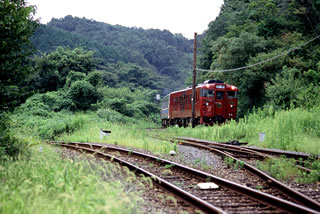 The only Loop switchback in Japan on a compound railway.
Within the loop there is unusual feature station.
The Japanese railroad department from the Meiji era, operates even now from the original challenge.
Although rail lines are all over Japan.
This line overcomes mountain barriers of construction, it is very impressive.
The only Loop switchback in Japan on a compound railway.
Within the loop there is unusual feature station.
The Japanese railroad department from the Meiji era, operates even now from the original challenge.
Although rail lines are all over Japan.
This line overcomes mountain barriers of construction, it is very impressive.【View Point】
- The train conductor operates from the front as well as the back so his skill is admired.
- We can experience the best 360°view in Japan.
- There is a panoramic view point because of the large pitch difference.
Welcoming travelers for more than one hundred years・・break spot on the mountain pass.

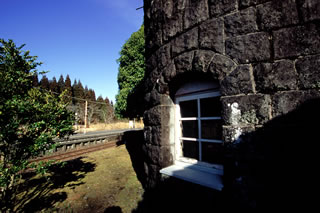 Only station in Japan located on a loop switchback line. Next to the station, there is a stone water tank used to cool during the SL era.
There is the flower shaped pool that can be seen even today that come up on railway train travelogue novel "Awa train" which is written by Uchida Hyakumon.
The Okoba sign board’s color and writing remain unchanged, it evokes a memory from the old days.
Only station in Japan located on a loop switchback line. Next to the station, there is a stone water tank used to cool during the SL era.
There is the flower shaped pool that can be seen even today that come up on railway train travelogue novel "Awa train" which is written by Uchida Hyakumon.
The Okoba sign board’s color and writing remain unchanged, it evokes a memory from the old days.【View Point】
- The station and wooden ticket gate keep the travelers memory from the Meiji era.
- The natural statue has the soul of many railroad workers.
- The Hitoyoshi plum garden is very near the station, We can enjoy a modernization inheritance and a natural view.
A difficult tunnel to construct of the railroad days of creation even now runs through the mountain pass of the prefectural border.
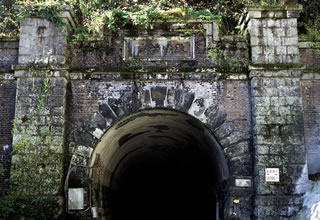
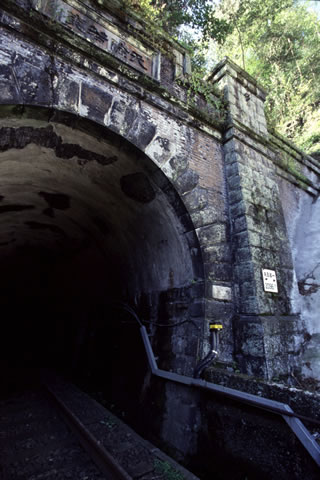 The D51 type steam locomotive of the double-header slowly climbed the rapid slope of up to Thirty-1000ths incline.
Yatake Station is at the top of 540m above sea level.
Upon entering Miyazaki, the first of Mt. Yatake tunnel appears in the south of the station.
It is the Hisatsu Line’s longest tunnel which took more than three years to dig.
There is a stone plaque in the calligraphy of Yamagata Isaburou and Goto Shinpei at both the entrance and exit of the tunnel.
It was difficult to construct, and there is an episode of a transportation horse that died by a flood.
The D51 type steam locomotive of the double-header slowly climbed the rapid slope of up to Thirty-1000ths incline.
Yatake Station is at the top of 540m above sea level.
Upon entering Miyazaki, the first of Mt. Yatake tunnel appears in the south of the station.
It is the Hisatsu Line’s longest tunnel which took more than three years to dig.
There is a stone plaque in the calligraphy of Yamagata Isaburou and Goto Shinpei at both the entrance and exit of the tunnel.
It was difficult to construct, and there is an episode of a transportation horse that died by a flood.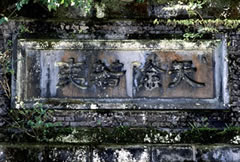
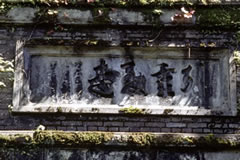
【View point】
- The stone plaque「Tenkeninogotoshi as said by communication minister Yamagata Isaburou.
- The stone plaque「Omokiwohikitetookinitisu as said by President of the railroad, Baron Goto Snpei.
- At the entrance, there are grand piling-stones made from plaster on both sides.
Small stone storehouse of tufa recalling the railroad days of creation of South Kyushu
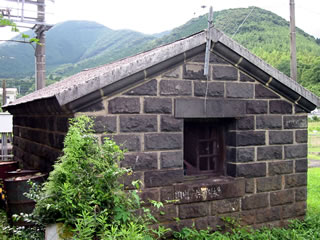 Yoshimatsu from Yokogawa on the Kagoshima Line was inaugurated to lengthen from Kagoshima to Osumi Yokogawa in September in 1903.
Yoshimatsu Station was founded soon. This area led to Miyazaki via the Kitto Line.
It became the base of the railroad in South Kyushu and prospered as the pivot point of rail traffic.
The stone bunker was constructed at the time of opening Yoshimatsu Station.
It was made from tufa unique to South Kyushu. It was skillfully and strongly constructed.
It is a small precious inheritance to know the history of Hisatsu Line.
Yoshimatsu from Yokogawa on the Kagoshima Line was inaugurated to lengthen from Kagoshima to Osumi Yokogawa in September in 1903.
Yoshimatsu Station was founded soon. This area led to Miyazaki via the Kitto Line.
It became the base of the railroad in South Kyushu and prospered as the pivot point of rail traffic.
The stone bunker was constructed at the time of opening Yoshimatsu Station.
It was made from tufa unique to South Kyushu. It was skillfully and strongly constructed.
It is a small precious inheritance to know the history of Hisatsu Line.【View point】
- The bunker’s cut tufa stone is beautiful stuck and tightly layered.
- Cut stone supports upper construction and the window allows for water to escape
- The roof beams are supported by carved gables wall
Railroad line steps over the waterway of the brick carrying a rich spring
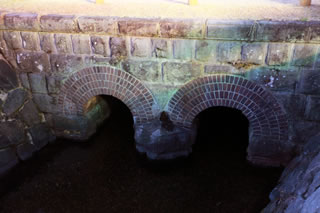 Maruike water pool near Kurino Station comes up from Kirishima’s clean mountain water.
The brick culvert carries water under Hisatsu line. The portal is small however the culvert is 67meters long and supports many lines.
Maruike water pool near Kurino Station comes up from Kirishima’s clean mountain water.
The brick culvert carries water under Hisatsu line. The portal is small however the culvert is 67meters long and supports many lines.【View Point】
- The scenery of the beautiful culvert to be able to enjoy with a spring.
- The stubborn structure by the combination of ignimbrite and brick like Kagoshima.
- Beauty of the brick round arch which was put on several levels.
The old-fashioned station building which conveys a scar of the war damage even now.
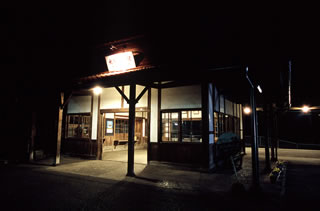
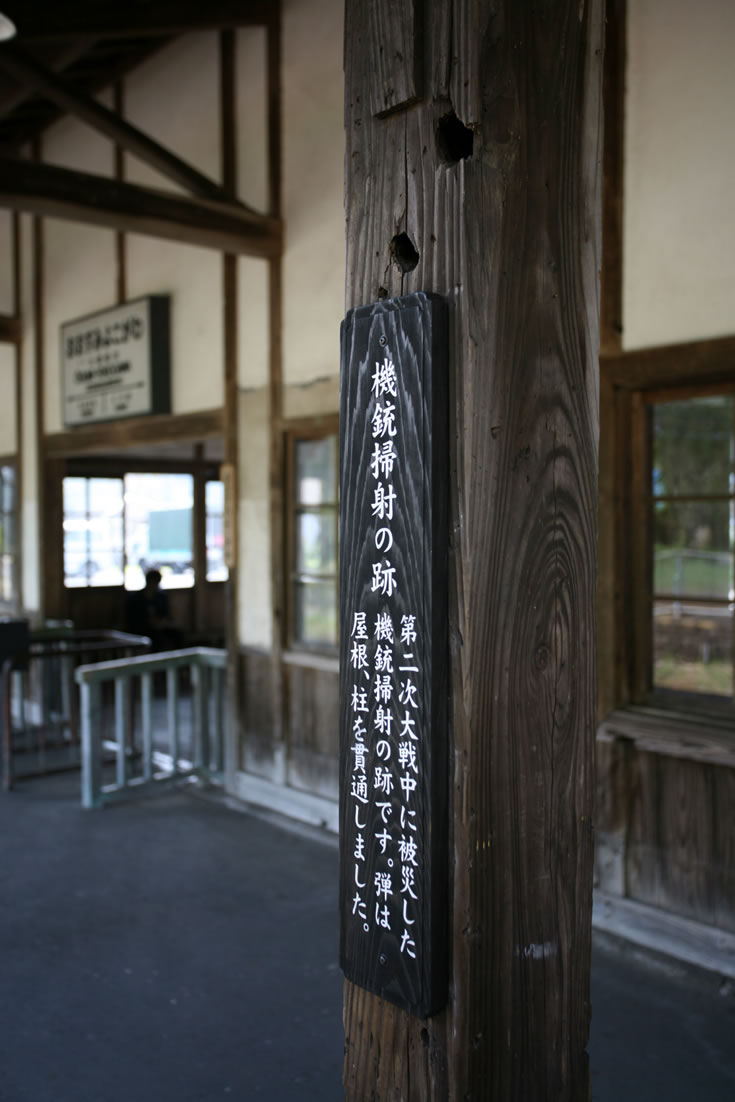
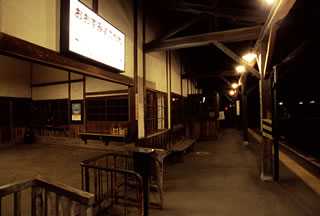 In about September (Meiji 36) 1903 the Yoshimatsu - Hayato interval started as a business as Kagoshima line as a government railway.
One charm of the Hisatsu Line is that the station building is left as original construction from the time of the opening of business.
Osumi-Yokogawa Station sees the design like the station of the Meiji in its details.
A sign marked by the machine-gun penetration in the Pacific War remains on the pillar supporting a customs shed covering the platform and is a war damage remain.
The wooden bench shows the sealed pattern used at Japanese National Railway Stations in Kyushu.
In addition, "the staff receiver" which is on the island platform, when a limited express or express train run in a front section the conductor throws a tablet . There are extremely few remaining examples and it is valuable nationwide.
In about September (Meiji 36) 1903 the Yoshimatsu - Hayato interval started as a business as Kagoshima line as a government railway.
One charm of the Hisatsu Line is that the station building is left as original construction from the time of the opening of business.
Osumi-Yokogawa Station sees the design like the station of the Meiji in its details.
A sign marked by the machine-gun penetration in the Pacific War remains on the pillar supporting a customs shed covering the platform and is a war damage remain.
The wooden bench shows the sealed pattern used at Japanese National Railway Stations in Kyushu.
In addition, "the staff receiver" which is on the island platform, when a limited express or express train run in a front section the conductor throws a tablet . There are extremely few remaining examples and it is valuable nationwide.【View Point】
- The wooden building evokes an old time feeling as a station of the Meiji era that passed in 100 years
- Marking of the machine-gun in the Pacific War penetrate the pillar of the station penthouse even now.
- "The staff receiver" for passing trains is left on the island platform.
Travelers gather at the station of The Meiji era to see a railroad line of 100 years ago.
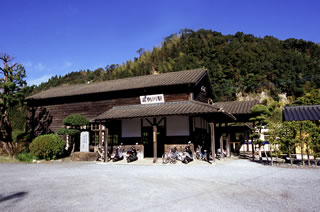
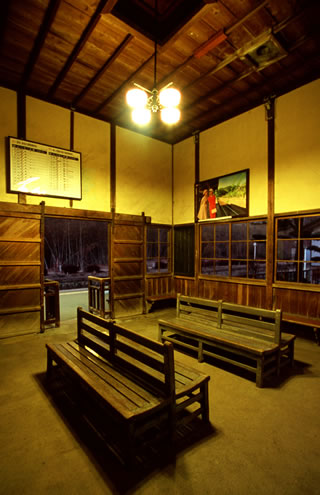 It opened in 1903(Meiji36).
The sealed pattern station building of the original construction can be seen in the station building at the time of the Hisatsu Line opening of business.
The remainder is a station office and the night-duty room with half of the building in a waiting room. The waiting room has a teller for the ticket sale and feels nostalgic becausea wooden counter.
On the illumination of the ceiling, there are irregular patterns department because of the vent. When I pass through the wooden gate and appear on the platform, there is a built-in bench on the right and left. There is decoration of the cloud design to the support board.
It is on the waiting room bench in Osumi Yokogawa Station, it was used with the shape of the station building at a station at the time of the opening of business along the line.
It is 110 years old.
The lucky station is given nostalgia and impressing for a traveler.
It opened in 1903(Meiji36).
The sealed pattern station building of the original construction can be seen in the station building at the time of the Hisatsu Line opening of business.
The remainder is a station office and the night-duty room with half of the building in a waiting room. The waiting room has a teller for the ticket sale and feels nostalgic becausea wooden counter.
On the illumination of the ceiling, there are irregular patterns department because of the vent. When I pass through the wooden gate and appear on the platform, there is a built-in bench on the right and left. There is decoration of the cloud design to the support board.
It is on the waiting room bench in Osumi Yokogawa Station, it was used with the shape of the station building at a station at the time of the opening of business along the line.
It is 110 years old.
The lucky station is given nostalgia and impressing for a traveler.【View Point】
- The taste of the wooden station building of the Meiji era remains well
- It shows the history of household articles including the wooden built-in bench and gate.
- A feeling of heavy history is felt from the stone masonry of the station.

A western-style small brick power station shines in the blue Kuma River
 In the middle of the Meiji era, modern paper manufacturing industry was planned with water and the forest resources which are rich in the Kuma River as raw materials.
Fukami power station was built to send electricity to the paper mill established in former Sakamoto.
Since completion of 1921, a generator at the time of the establishment was used until 1988. It remains even now in the building.
The origin of the paper manufacturing industry to support Yatsushiro city is right here.
In 2008, reroofing was carried out by an effort of Nippon Paper Industries which was an owner, and a beautiful figure was revived.
In the middle of the Meiji era, modern paper manufacturing industry was planned with water and the forest resources which are rich in the Kuma River as raw materials.
Fukami power station was built to send electricity to the paper mill established in former Sakamoto.
Since completion of 1921, a generator at the time of the establishment was used until 1988. It remains even now in the building.
The origin of the paper manufacturing industry to support Yatsushiro city is right here.
In 2008, reroofing was carried out by an effort of Nippon Paper Industries which was an owner, and a beautiful figure was revived.【View point】
- The beautiful brick European-style building which symbolizes the completed times.
- Hisatsu Line goes along the back side and one can see the brick building from point-blank range.
- A water pipe at the time of the operation is left in the steep slope of the power station, and there is a surge tank on the mountain.
Power station of the modern chemical origin emerges from the bottom of a lake like a summer illusion
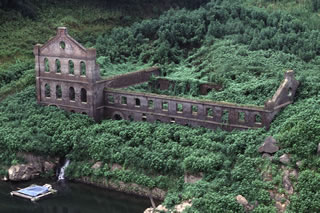
 It is unique in some modernization inheritance in Kyushu here.
The power station which sank into the bottom of a lake since the Tsuruda Dam completion in 1966 appears in the water now from spring to autumn.
Sogi power station was built in 1909.
Power supply for the drainage to Ushio Okuchi Kinzan and the power supply to the Okuchi district were the purposes.
It is the second power station to be in existence.
Shitagau Noguchi was the founder who became a father of the chemical industry of Japan.
Calcium carbide production was started in Minamata City, Kumamoto Prefecture to transmit electricity by the surplus electric power of the Noguchi power station.
It became Japanese nitrogenous fertilizer Co., Ltd., and it is in a forerunner of Chisso Corporation, Asahi Chemical Industry Co., Ltd., Sekisui industry Co., Ltd.
In the old days of the chemical industry the huge turbine room and the control station had a generator made in Germany. Now only a wall surface remains. The turbine room from the productive old days of the power station remains quietly now.
It is unique in some modernization inheritance in Kyushu here.
The power station which sank into the bottom of a lake since the Tsuruda Dam completion in 1966 appears in the water now from spring to autumn.
Sogi power station was built in 1909.
Power supply for the drainage to Ushio Okuchi Kinzan and the power supply to the Okuchi district were the purposes.
It is the second power station to be in existence.
Shitagau Noguchi was the founder who became a father of the chemical industry of Japan.
Calcium carbide production was started in Minamata City, Kumamoto Prefecture to transmit electricity by the surplus electric power of the Noguchi power station.
It became Japanese nitrogenous fertilizer Co., Ltd., and it is in a forerunner of Chisso Corporation, Asahi Chemical Industry Co., Ltd., Sekisui industry Co., Ltd.
In the old days of the chemical industry the huge turbine room and the control station had a generator made in Germany. Now only a wall surface remains. The turbine room from the productive old days of the power station remains quietly now.【View Point】
- It gradually appears in the surface of the lake in early spring. It becomes the mysterious ruins that die underwater again when it is early fall.
- Walls of the solid brick buildingt are still left well, and a connection of arches is beautiful.
- We can see the sidewall of the turbine room and the gable wall of the huge control station with four generators.
